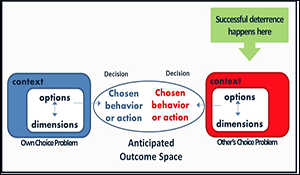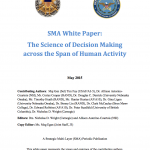Science of Decision Making Across Human Activity

The Science of Decision Making Across the Span of Human Activity.
Author | Editor: Wright, N. (University of Birmingham & Carnegie Endowment for International Peace) & Astorino-Courtois, A. (NSI, Inc).
The US is affected by the decisions of highly diverse actors, ranging from individuals, to groups (e.g. Violent Extremist Organizations; VEOs) to large and sophisticated states. The behavior of actors at any of these levels can seem “irrational” or “incomprehensible” and thus difficult to deter or influence. Understanding seemingly incomprehensible decision making is even more crucial given the growing centrality of hybrid warfare to the challenges US planners face.
Decisions are made in context and, except for the most extreme (either dire or trivial), they bear on the multiple concerns, preferences and interests a decision maker may have. The choice problems that prompt decisions are comprised of three elements: 1) the options for action an actor believes he/she has; 2) the dimensions (concerns, interests) that determine his preferences over those options; and 3) what he believes other relevant actors will do (i.e., the options and preferences attributed to others, in some cases including the state of nature.) The range of outcomes and actor expected is determined by combining his own options with what he expects others to do. In general, the difference between decision models based on strict rationality assumptions (i.e., rational choice, game theoretic approaches, expected utilty/cost benefit analyses) and those that relax or eliminate these assumptions lies in their suppositions about the nature of the processes by which multi- dimension choice problems are solved and the factors that impinge upon those processes.
Decision Making and Deterrence
Deterring unfavorable actions either by an adversary or a friend is an issue of perception; it has to do with our ability to influence how others construct their choice problems. From a decision-making perspective then, successful deterrence requires the power to alter another’s perception of the demands associated with achieving his objectives to the degree that he chooses to forego actions he would otherwise take. It is important to note that even decision approaches that include “non-rational” factors such as a decision maker’s affective state, health problems, or fatigue, still rely on assumptions about basic human or group behavior. Namely, that their actions are purposeful and that people seek to avoid self-injury or harm however they may define it. Grasping a potential adversary’s understanding of what is injurious or harmful, the interests that impinge on a choice of action, the constraints imbedded in that choice problem, and the process by which it is solved are the critical information requirements for planning to deter terror attacks, regional conflict, nuclear proliferation and even weaponization of space.
US planners and decision makers will require sophisticated analyses related to each of these factors to evaluate how deterrence messages and signals are likely to be received by adversaries and even which alternative, less unfavorable adversary behaviors might be encouraged. They will need the same types of understanding regarding ally decision making in order to send the most effective messages regarding US resolve to extend our deterrent capabilities to their shores.
A final note involves something very often overlooked in US deterrence planning: understanding the political, bureaucratic and social preferences and obligations that condition our own choice problems and decisions. This helps us better appreciate and plan against those circumstances in which we may be self-deterred, and when our own choice processes pose barriers to effective implementation of deterrence messaging or actions.
The Science of Decision Making across the Span of Human Activity
The types of hybrid conflicts that appear to have become the “new normal” in global affairs require equally hybrid response including deterring decisions being made by individuals, groups and states operating simultaneously (e.g. in Ukraine) in various parts of the globe. Taken together the chapters that comprise this volume describe how seemingly incomprehensible decisions made at different levels of analysis most often arise from the predictable ways that individuals, groups and states function. This is a first step in generating the sophisticated understanding of deterrence decisions.
In Chapter 1 Nick Wright draws from neuroscience research to explain adversary behaviors in terms of brain functions and behavioral responses. This predicts different responses to threats intended to deter adversaries versus threats intended to compel other behaviors – and when identical threats provoke attack. He also points out how easy it is to misinterpret an adversary’s activities and response to our own activities simply by our failure to consider the impacts of perceived unfairness.
In Chapter 2 Peter Suedfeld describes the conceptual progress of less dynamic to more dynamic decision theories and models. He presents his cognitive managerial model to help explain how cognitive factors and decision processing at the individual level are conditioned by the nature of the circumstance that the decision maker finds himself at the time of decision.
Clark McCauley moves the discussion to the level of group decision making in Chapter 3. He explains why group decisions are more than just the sum of individual choices. He presents an evolved group dynamics theory to explain how the type of attractiveness that defines the group can result in either: hyper consensual and often premature choice (groupthink); or can polarize the group beyond where its individuals members would have gone alone (e.g. with implications for radicalization).
In Chapter 4 David Gompert, Hans Binnendijk and Bonny Lin discuss twelve cases of war and peace decision making by national leaders and the role that the leaders’ cognitive models and personality traits play in marking the difference between what have been seen as state-level blunders and national security successes.
In Chapter 5 Gina Ligon and Douglas Derrick point out that there are decision dimensions included in VEO decision making that are unique to those types of organizations, including for example, the need for increasing violence both for reasons of organizational credibility and to maintain public attention. VEO decisions can appear to be incomprehensible or unpredictable if we consider violence as a VEO decision variable or concern rather than just a tactic.
In Chapter 6 Timothy Heath and Cortez Cooper provide an analysis of Chinese national security decision making, and in the final chapter Ed Robbins and Hunter Hustus provide the practitioners view of the value of deterrence over compellence in achieving US national security goals.
In addition to their individual contributions, two broader themes emerge when the chapters in this white paper are taken together:
- Internal Structures Condition Decisions and Behavior at all Levels of Analysis. Observable decisions are often the result of competition and interaction between internal systems, beliefs, interests, factions, components or bureaucracies. Even if not the intention, seemingly inconsistent or even self-defeating behaviors and decisions can arise even from normal functioning of these internal components as internal struggles play out in different contexts. This is true at the level of the individual decision maker where different systems in the brain constitute those structures; at the group level where the attractiveness or source of cohesion and the form of interdependence among group members significantly impact group norms and decision; and at the organization level where internal structures such as bureaucracies can incentivize certain choices and make decisions and actions inconsistent.
- Especially in Ambiguous Operating Environments the Analysis of Adversary Decision Making must be Multi-level. Decision making has common features across levels as well as features specific to the each level. As the categorical boundaries between forms of conflict are increasingly replaced by ambiguous operating environments, the best insight into an adversary’s behavior will require study of decision process and contextual factors on multiple levels of analysis (e.g., individual leader integrative complexity within the context of the structure and norms of his decision group and the bureaucratic pressures of his organization).
Contributing Authors
Maj Gen (Sel) Tim Fay (USAF/A3-5), Dr. Allison AstorinoCourtois (NSI), Mr. Cortez Cooper (RAND), Dr. Douglas C. Derrick (University Nebraska Omaha), Mr. Timothy Heath (RAND), Mr. Hunter Hustus (AF/A10), Dr. Gina Ligon (University Nebraska Omaha), Dr. Bonny Lin (RAND), Dr. Clark McCauley (Bryn Mawr College), Dr. Edward Robbins (AF/A10), Dr. Peter Suedfeld (University of British Columbia), Dr. Nicholas D. Wright (Carnegie)

Comments